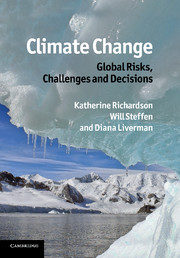Book contents
- Frontmatter
- Contents
- Writing team
- Foreword
- Preface
- List of acronyms and abbreviations
- Part I Climatic trends
- Part II Defining ‘dangerous climate change’
- 5 The impact of climate change on human societies
- 6 Impacts of climate change on the biotic fabric of the planet
- 7 Tipping elements: jokers in the pack
- 8 Linking science and action: targets, timetables and emission budgets
- Part III Equity issues
- Part IV Mitigation and adaptation approaches
- Part V Meeting the challenge
- Index
- Plate section
- References
7 - Tipping elements: jokers in the pack
Published online by Cambridge University Press: 04 April 2011
- Frontmatter
- Contents
- Writing team
- Foreword
- Preface
- List of acronyms and abbreviations
- Part I Climatic trends
- Part II Defining ‘dangerous climate change’
- 5 The impact of climate change on human societies
- 6 Impacts of climate change on the biotic fabric of the planet
- 7 Tipping elements: jokers in the pack
- 8 Linking science and action: targets, timetables and emission budgets
- Part III Equity issues
- Part IV Mitigation and adaptation approaches
- Part V Meeting the challenge
- Index
- Plate section
- References
Summary
‘This is an externality like no other… there is a big probability of a devastating outcome’
Striking developments in the climate system in recent years have reinforced the view that anthropogenic global warming is unlikely to cause a smooth transition into the future. The record minimum area coverage of Arctic sea-ice in September 2007 drew widespread attention, as has the accelerating loss of water from the Greenland and West Antarctic ice sheets (Chapter 3). These large-scale components of the Earth System are among those that have been identified as potential ‘tipping elements’ – climate sub-systems that could exhibit a ‘tipping point’ where a small change in forcing (in particular, global temperature change) causes a qualitative change in their future state (Lenton et al., 2008). The resulting transition may be either abrupt or irreversible, or in the worst cases, both. The most ‘policy-relevant’ tipping elements have been defined as those that (i) have a tipping point that could be crossed this century, (ii) would undergo, as a consequence, a qualitative change within this millennium, thereby (iii) affecting (if not damaging) a large number of people. For a full definition of a tipping element and its tipping point, see Box 7.1 (and Lenton et al., 2008). In IPCC terms such changes are referred to as ‘large-scale discontinuities’ (Smith et al., 2009). Should they occur, they would surely qualify as dangerous climate changes (Schellnhuber et al., 2006) (although not all are equally dangerous, as we will explore further).
- Type
- Chapter
- Information
- Climate Change: Global Risks, Challenges and Decisions , pp. 163 - 201Publisher: Cambridge University PressPrint publication year: 2011
References
- 2
- Cited by



